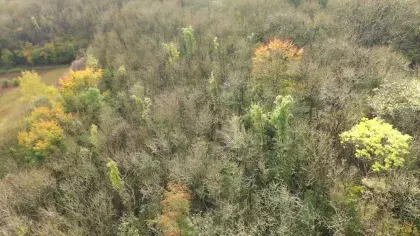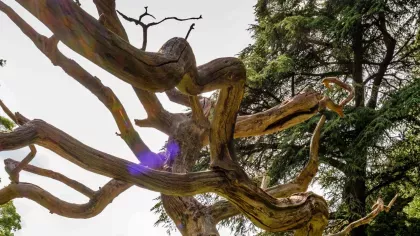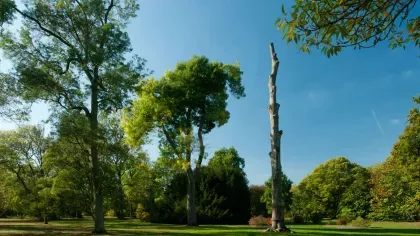16 August 2023
Life, language and legends: The significance of ash
Over 900 species rely on ash trees – bullfinches feed on the seeds, while the lichen on the bark provides nutrients to caterpillars. But they are under threat.

Ash dieback (Hymenoscyphus fraxineus) is the most devastating tree disease to hit the UK in 60 years. It's expected to kill up to 75% of ash trees across the country.
Ash dieback exists in parallel with the twin threats of climate change and biodiversity loss, and recent extreme weather has only accelerated its spread.
At Wakehurst, whilst we carry out a major felling operation and undertake ground-breaking research behind the scenes, we’re also raising awareness of ash dieback in a creative way this summer.
Did you know? Ash is the third most common tree in Britain!

A blank canvas
Last December, our Arboretum team embarked on a major felling operation to prevent diseased trees across the site from posing a risk to the public.
In some cases, the remaining trunks of diseased trees have been left; a stark reminder of the rate at which ash canopies are disappearing from our woodlands.
These trunks provide a blank canvas; a space in which we can provide a voice to our ash trees. After all, our summer programme Rooted is all about bringing the story of trees to life in our gardens, telling tales of the benefits they bring and the challenges they face.
Enter SinnaOne.
Brighton-based graffiti artist, SinnaOne, has transformed these plagued pillars into striking works of art. His work breaths life back into the trunks to raise awareness of the impact of ash dieback and the loss of these critical trees in our landscape.
'I have worked with many different surfaces over the years and was surprised when this project came about as I had never painted on trees before – it wasn't something that I had ever considered.
Upon learning more about ash dieback, and its devastating effect on woodlands across the world, I understood how important it is to raise awareness... This project [is] not only about highlighting the problems of ash dieback but also looking forward with a message of hope for the future.'

Nature's warriors
As the fight against ash dieback continues, each tree becomes a warrior – a message that SinnaOne wanted to bring to the forefront through his artwork: 'I looked at the five monoliths as ancient tribal warriors that have been injured and fallen in battle.'
Whilst you wander through Bethlehem and Coates Wood, look out for tree trunks proudly wearing war paint, with some sporting targets to highlight their vulnerability to the disease. The large stripes on another represent bandages, placed on its cut limbs as it tries to heal, with shapes that mimic the changes that ash leaves go through as dieback takes hold.
But the significance of these ash trees and their markings go deeper, which is something that SinnaOne wanted to convey through colours, shapes and patterns.


Reborn from the ashes
For centuries, ash trees have been a symbol of healing, magic and life.
In many religions and folklore tales from across the world, there is a ‘world tree’ or ‘tree of life’; a cosmic pillar linking the heavens, Earth and underworld, also known as an ‘axis mundi’
In Norse mythology, this is an ash tree.
Known as 'Yggdrasil' in Norse legend, a sacred ash tree encompasses all Nine Worlds within the cosmos and stands right at its centre. With its branches reaching the heavens, and roots delving deep into the underworld, Yggdrasil houses the worlds of both humans and gods, nestled within a single tree.
Anyone familiar with Thor’s ventures in the Marvel franchise will know of the powerful Odin. It is generally believed that the name Yggdrasil derives from ‘Odin’s horse’ – 'drasill' meaning horse and 'Ygg(r)' being one of Odin’s many names.
Odin's relationship with Yggdrasil is recounted in the Poetic Edda, a collection of old Norse narrative poems. The writing tells of how the Yggdrasil was both Odin’s own gallows and the source of new life after Norse mythology’s apocalyptic Ragnarök.
Yggdrasil, and thus ash trees, are a symbol of life and death, the very story we are telling in our woodlands today.

Pillars and poles
For centuries, the idea of 'axis mundi' has revolved (literally) around poles, with the line between our planet’s two poles representing an invisible pillar.
Poles have been an important symbol in indigenous cultures across islands and coastal areas in the Pacific Northwest of America, serving as symbols of a family’s lineage and heritage. The poles can also represent a connection with the earth, with each feature telling its own story, and simultaneously acting as a welcome to visitors.
'I wanted to create iconography and war paint for each tree and celebrate them individually. Using mark-making and abstract shapes, I intend to represent death and rebirth, sickness and wellness. I also wanted to include patterns that were influenced by the effects of ash dieback and the general life of a tree.'

Written in history
The importance of trees is woven into medieval history, notably in ‘Ogham’, thought to be the first form of writing ever used in the Irish language. Read vertically, from bottom to top, each letter was named after a different tree, including ash.
There have been many discussions about the etymology of the language, but it is widely agreed that the 17th letter of the Old Irish Ogham alphabet ‘onn’ means ‘ash-tree’, with the earliest inscriptions dating back to the 4th Century.
Ash was quite literally written into our history, so it’s our responsibility to make sure it features in the stories of our future too.

A new generation
The final tree in the trail represents hope for the future. Bright colours start to break through, opening the door to a new world and the rebirth of a new generation.
Behind the scenes, our experts are undertaking ground-breaking seed research and carrying out multiple ash tree seed collection trips, taking a closer look at the DNA of resilient species.
Over the last decade, Kew scientists have been conducting pioneering studies to explore correlations between genetic variants in healthy and unhealthy ash trees. With data indicating that the health of trees can be predicted from their genomes, Kew is now exploring the possibility of an ash breeding scheme to help secure a future for the native tree species.


Through our Nature Unlocked research, we’re delving even deeper into the power of trees. As carbon-storing, pollinator-supporting, flood defences, our woodlands are fundamental in the fight against climate change.
And it’s vital we protect them.



